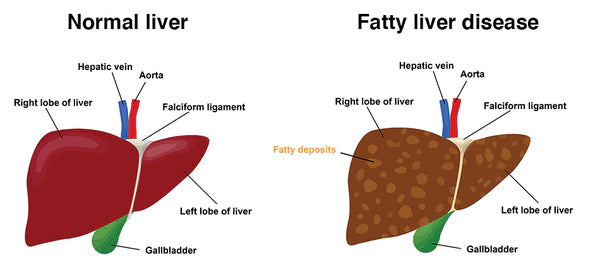Your liver is the second-largest organ in your body. It helps process nutrients from food and drinks and filters harmful substances from your blood. Too much fat in your liver can cause liver inflammation, which can damage your liver and create scarring. In severe cases, this scarring can lead to liver failure.

What are the symptoms of fatty liver disease?
Fatty liver disease usually doesn’t cause symptoms. People who have symptoms may:
- feel tired or generally unwell
- have pain in the upper right part of their abdomen
- lose weight
Fatty liver can progress through four stages:
- Simple Fatty Liver: There’s a buildup of excess fat in the liver. Simple fatty liver is largely harmless if it doesn’t progress.
- Steatohepatitis: In addition to excess fat, there’s also inflammation in the liver.
- Fibrosis: Persistent inflammation in the liver has now caused scarring. However, the liver can still generally function normally.
- Cirrhosis: Scarring of the liver has become widespread, impairing the liver’s ability to function. This is the most severe stage and is irreversible.
Are you pear-shaped or apple-shaped?
Fat accumulated in the lower body (the pear shape) is subcutaneous, while fat in the abdominal area (the apple shape) is largely visceral. Where fat ends up is influenced by several factors, including heredity and hormones. As the evidence against abdominal fat mounts, researchers and clinicians are trying to measure it, correlate it with health risks, and monitor changes that occur with age and overall weight gain or loss.
The fat you can pinch is subcutaneous fat. The fat inside your belly (the visceral fat) can be seen and measured, but not pinched.
Causes and Risk Factors
The cause of belly fat or fatty liver disease is not entirely clear. However, genetics may play a role. In fatty liver disease, excess fat is stored in liver cells, where it accumulates. A variety of factors can cause this fat buildup.
Some health conditions can increase the risk of developing NAFLD.
These include:
- having overweight or obesity
- high blood pressure
- type 2 diabetes
- metabolic syndrome, which is a group of medical conditions and characteristics linked to obesity.
- insulin resistance
High levels of fat in a person’s blood, such as high cholesterol and triglycerides, can also contribute to the risk of developing fatty liver disease.
The main risk factor for AFLD is drinking heavy amounts of alcohol. The Centers for Disease Control and Prevention (CDC) defines heavy drinking as:
- 15 or more drinks per week for men
- 8 or more drinks per week for women
Diagnosis
It can be difficult for a person to know when to seek advice from a doctor because fatty liver disease often has no symptoms. Doctors will consider a person’s medical history, diet, and lifestyle habits. They will also carry out a physical examination and do other tests to help diagnose fatty liver disease
How is fatty liver treated, and is it reversible?
There are no medicines to treat fatty liver disease. Treatment involves making changes to your lifestyle. This can improve the condition and even reverse it. If your fatty liver is caused by alcohol, then the most important thing to do is give up alcohol. This will prevent you from developing a more serious condition.

